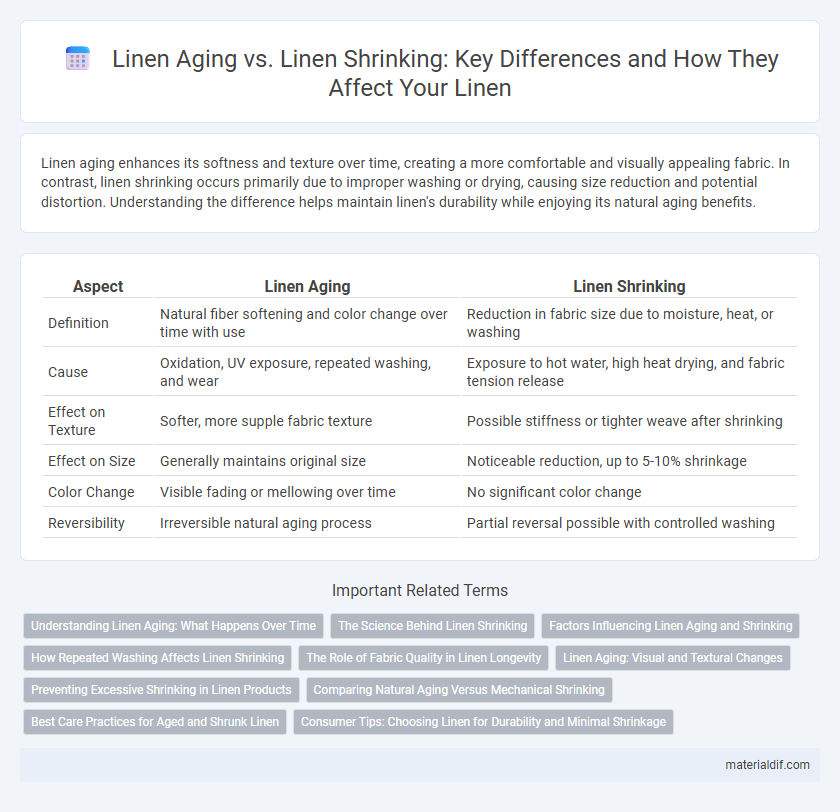Linen aging enhances its softness and texture over time, creating a more comfortable and visually appealing fabric. In contrast, linen shrinking occurs primarily due to improper washing or drying, causing size reduction and potential distortion. Understanding the difference helps maintain linen's durability while enjoying its natural aging benefits.
Table of Comparison
| Aspect | Linen Aging | Linen Shrinking |
|---|---|---|
| Definition | Natural fiber softening and color change over time with use | Reduction in fabric size due to moisture, heat, or washing |
| Cause | Oxidation, UV exposure, repeated washing, and wear | Exposure to hot water, high heat drying, and fabric tension release |
| Effect on Texture | Softer, more supple fabric texture | Possible stiffness or tighter weave after shrinking |
| Effect on Size | Generally maintains original size | Noticeable reduction, up to 5-10% shrinkage |
| Color Change | Visible fading or mellowing over time | No significant color change |
| Reversibility | Irreversible natural aging process | Partial reversal possible with controlled washing |
Understanding Linen Aging: What Happens Over Time
Linen aging involves natural fiber relaxation and softening, enhancing fabric texture and durability as it is exposed to repeated washing and wear. Over time, linen undergoes gradual fiber breakdown, leading to subtle color fading and a more pliable handfeel, distinct from the irreversible dimensional changes seen in linen shrinking. Understanding these processes helps preserve linen's longevity, ensuring its characteristic breathability and strength remain intact despite natural aging phenomena.
The Science Behind Linen Shrinking
Linen shrinking occurs primarily due to the natural fibers' response to moisture and heat, causing the cellulose chains in flax fibers to contract and tighten. Unlike aging, which gradually softens linen fibers through repeated use and washing, shrinking alters the fabric's structure by reducing its length and width. Understanding the molecular behavior of flax fibers during exposure to water and heat reveals that controlled laundering can minimize unwanted shrinkage and maintain linen's durability.
Factors Influencing Linen Aging and Shrinking
Linen aging is influenced by factors such as exposure to sunlight, humidity, and frequent washing, which can gradually soften the fibers while maintaining fabric durability. Linen shrinking, however, primarily occurs due to water temperature during laundering and the type of drying method used, with hot water and high-heat drying causing more significant shrinkage. Proper care like using cold water washes and air drying can minimize shrinkage and preserve linen's quality over time.
How Repeated Washing Affects Linen Shrinking
Repeated washing causes linen fibers to contract and tighten, leading to noticeable shrinking over time. The natural cellulose structure in linen responds to water and agitation by reducing fabric dimensions, often resulting in up to 5% shrinkage after multiple washes. Proper care, including gentle cycles and cold water, minimizes excessive shrinking while preserving linen's durability and texture.
The Role of Fabric Quality in Linen Longevity
Fabric quality plays a crucial role in determining linen longevity, impacting both aging and shrinking processes. High-quality linen, woven from long flax fibers, resists excessive shrinking and maintains strength through repeated washes, promoting durability. Lower-quality linen, often made from shorter fibers, tends to shrink more and deteriorate faster, resulting in premature wear and loss of fabric integrity.
Linen Aging: Visual and Textural Changes
Linen aging causes gradual softening and a patina that enhances its natural luster and strength over time. The fabric develops subtle color variations and a unique texture due to repeated washing and exposure to light. Unlike shrinking, aging improves linen's comfort and aesthetic appeal without compromising its dimensions.
Preventing Excessive Shrinking in Linen Products
Linen fibers naturally contract when exposed to water and heat, causing some shrinkage after the initial wash, but excessive shrinking can be prevented by washing linen products in cold water and avoiding high-temperature drying methods. Pre-washing linen fabric before cutting and sewing helps minimize future shrinkage by stabilizing the fibers. Proper care, including air drying and using gentle detergents, maintains the integrity and longevity of linen products without compromising their texture or fit.
Comparing Natural Aging Versus Mechanical Shrinking
Natural aging of linen enhances its softness and strength through gradual fiber relaxation and oxidation, maintaining fabric integrity over time. Mechanical shrinking, caused by heat and agitation during washing or drying, leads to immediate dimensional reduction but may weaken fibers and cause uneven texture. Comparing both, natural aging preserves linen's durability while mechanical shrinking risks compromising fabric performance and appearance.
Best Care Practices for Aged and Shrunk Linen
Aged linen requires gentle washing in cold water to preserve fibers and prevent further wear, while shrunk linen benefits from careful stretching and reshaping during dampening to restore its original size. Avoid high heat drying for both aged and shrunk linen as it accelerates fiber breakdown and distortion. Using mild detergents and air drying flat prolongs the lifespan and maintains texture integrity for linen fabrics.
Consumer Tips: Choosing Linen for Durability and Minimal Shrinkage
Linen made from long flax fibers tends to age gracefully, becoming softer and stronger over time while resisting significant shrinkage. To ensure durability and minimal shrinkage, consumers should opt for pre-washed or stonewashed linen products, as these treatments stabilize the fabric's weave before purchase. Selecting high-quality, Belgian or French linen also enhances longevity due to tighter fiber construction and superior processing techniques.
Linen Aging vs Linen Shrinking Infographic

 materialdif.com
materialdif.com